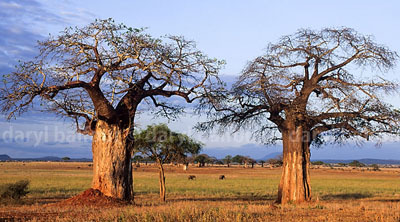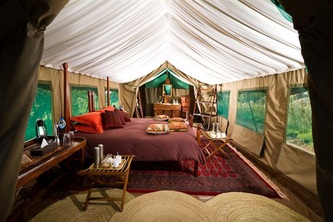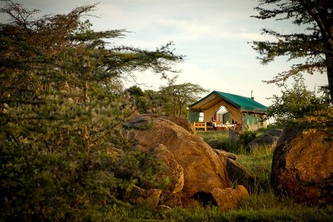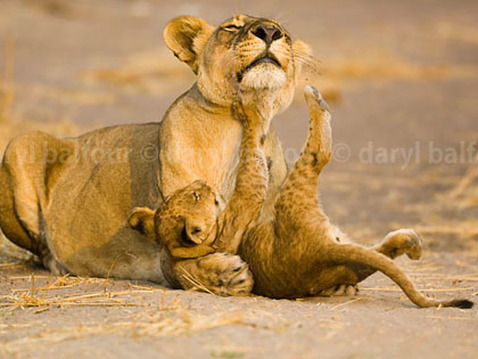TARANGIRE, KATAVI & MAHALE MOUNTAINS NATIONAL PARKS
a safari for 4 persons with Pierre Burton or Daryl Balfour
WE ARE CURRENTLY BOYCOTTING TRAVEL TO TANZANIA BECAUSE OF THEIR POLICIES ALLOWING THE SHOOTING OF AFRICA'S LAST REMAINING SUPER TUSKERS THAT WANDER ACROSS THE BORDER FROM KENYA

Tarangire's baobabs dwarf the park's many elephants.
Tanzania’s Best-Kept Secrets
Join Daryl Balfour &/or Pierre Burton on Safari with only 4 guests on an exclusive journey to three of Tanzania’s most remote and unexplored National Parks in October or at a time that suits you. (TBC) .
“Katavi is a place of adventure, a place where the animals still retain ownership. It is a place for connoisseurs of Africa, for those instilled with the spirit of Livingstone and Stanley. Mahale is about as remote, sedate and inaccessible a place one can find in today’s fast-paced and ever-shrinking world. It is also one of the hardest places to get to on the safari circuit, but it offers one of Africa’s most enthralling wildlife experiences.”
When I wrote these words in my Great Game Parks of Africa features for Africa Geographic magazine back in 2003 & 2004 I knew I would return time and again, and so it has been. Katavi has an allure that is hard to better, and if you love wilderness this is the place to be. Mahale, with its wonderful chimpanzee trekking, has become one of those “must visit” destinations that draw me back year after year.
Tarangire National Park, a park Sharna and I first visited in 1994 as part of the research for our elephant book, has developed a reputation over the years as one of Tanzania’s best places for seeing and photographing elephants, and we have timed this safari to take in the dry period when the elephants are concentrated around the perennial pools of the Tarangire River. The park is renowned for its giant baobabs, and in October each year these attract elephants to feed upon their moisture-laden trunks, one of the true spectacles of Nature. It is one of the truly impressive sights of Africa to watch one of the world’s mammalian giants feeding upon one of the giants of the floral kingdom!
Join Daryl Balfour &/or Pierre Burton on Safari with only 4 guests on an exclusive journey to three of Tanzania’s most remote and unexplored National Parks in October or at a time that suits you. (TBC) .
“Katavi is a place of adventure, a place where the animals still retain ownership. It is a place for connoisseurs of Africa, for those instilled with the spirit of Livingstone and Stanley. Mahale is about as remote, sedate and inaccessible a place one can find in today’s fast-paced and ever-shrinking world. It is also one of the hardest places to get to on the safari circuit, but it offers one of Africa’s most enthralling wildlife experiences.”
When I wrote these words in my Great Game Parks of Africa features for Africa Geographic magazine back in 2003 & 2004 I knew I would return time and again, and so it has been. Katavi has an allure that is hard to better, and if you love wilderness this is the place to be. Mahale, with its wonderful chimpanzee trekking, has become one of those “must visit” destinations that draw me back year after year.
Tarangire National Park, a park Sharna and I first visited in 1994 as part of the research for our elephant book, has developed a reputation over the years as one of Tanzania’s best places for seeing and photographing elephants, and we have timed this safari to take in the dry period when the elephants are concentrated around the perennial pools of the Tarangire River. The park is renowned for its giant baobabs, and in October each year these attract elephants to feed upon their moisture-laden trunks, one of the true spectacles of Nature. It is one of the truly impressive sights of Africa to watch one of the world’s mammalian giants feeding upon one of the giants of the floral kingdom!

Crocodiles mass in caves in the dry river bed in Katavi during the dry season.
Our days will be spent exploring the remote corners of the park by open safari vehicles with only 4 passengers to a vehicle, in the hope of seeing lion, leopard, elephant, buffalo and a host of other species. The dry-season refuge for much of Maasailand, animals throng here at this time of year, while the birdlife can be prolific.
We will spend three nights in Tarangire in a private seasonal tented camp prior to taking a charter flight further west to the remote and barely-travelled Katavi NP.
Katavi, Tanzania’s third-largest National Park, is so remote the only realistic way to get there is by air, with the result that the park only receives a handful of visitors each year. Home to some of the largest herds of buffalo left in Africa, Katavi teems with other wildlife such as elephants, hippos, lions, zebras, topi, roan antelope and crocodiles. The cave-dwelling crocs of Katavi (pic right) will soon feature in a National Geographic documentary and these huge reptiles are truly remarkable. Retreating to large holes or caves they have excavated in the riverbanks when the water dries up, they can be seen massed together like nowhere else on earth, literally interwoven together. This is a favourite destination of Daryl Balfour Wildphotos Safaris with memorable photo opportunities.
Katavi is said to be home to the largest herds of buffalo on earth, with these herds topping the 3000 mark at times. Lake Chada is also reputed to hold the highest density of hippo and crocodiles in Tanzania when it is full. Certainly during our visit last September we saw the most and the biggest crocs we’ve ever seen, scores of leviathans that easily topped the 6-metre mark! September being the height of the dry season, the floodplains were caked and dry and the only water remaining being seepages in the dried-up watercourses along their fringes. These seeps attract a never-ending procession of game throughout the day…and provide refuge for both crocodiles and hippos.
On our first afternoon on my first visit to Katavi we saw more than anyone could rightfully expect in any African game park – dozens of elephants, several hundred hippo, huge crocs, herds of topi and zebra numbering in the hundreds, a pride of lions asleep under a tree, countless giraffe, a group of eland, a pair of side-striped jackal and a lone spotted hyaena. That night a leopard prowled and growled around camp. On top of these four-legged attractions the birdlife was also exceptional, with palmnut vultures, sooty falcon and long-toed plover topping the list. Katavi has a bird-list of more than 400 species, so there is more than enough for even the most ardent of enthusiasts.
Accommodation for our four nights in Katavi will be in the traditional tented Chada Camp, with all our excursions being in customised open 4x4 vehicles on an exclusive basis. Large airy walk-in safari tents with en-suite facilities offer a true sense of being on safari while offering plenty of comfort and security, while meals are taken in the homely mess-tent or under the stars. All food and drink is included in our tariff, as well as complimentary daily laundry service.
From Katavi we take a short but scenic charter flight to the little airfield at Kungwe Bay on the shores of Lake Tanganyika, from where a 50-minute boat ride down the lake will take us to the romantic, rustic but luxurious Greystoke Camp in Mahale Mountains National Park.
We will spend three nights in Tarangire in a private seasonal tented camp prior to taking a charter flight further west to the remote and barely-travelled Katavi NP.
Katavi, Tanzania’s third-largest National Park, is so remote the only realistic way to get there is by air, with the result that the park only receives a handful of visitors each year. Home to some of the largest herds of buffalo left in Africa, Katavi teems with other wildlife such as elephants, hippos, lions, zebras, topi, roan antelope and crocodiles. The cave-dwelling crocs of Katavi (pic right) will soon feature in a National Geographic documentary and these huge reptiles are truly remarkable. Retreating to large holes or caves they have excavated in the riverbanks when the water dries up, they can be seen massed together like nowhere else on earth, literally interwoven together. This is a favourite destination of Daryl Balfour Wildphotos Safaris with memorable photo opportunities.
Katavi is said to be home to the largest herds of buffalo on earth, with these herds topping the 3000 mark at times. Lake Chada is also reputed to hold the highest density of hippo and crocodiles in Tanzania when it is full. Certainly during our visit last September we saw the most and the biggest crocs we’ve ever seen, scores of leviathans that easily topped the 6-metre mark! September being the height of the dry season, the floodplains were caked and dry and the only water remaining being seepages in the dried-up watercourses along their fringes. These seeps attract a never-ending procession of game throughout the day…and provide refuge for both crocodiles and hippos.
On our first afternoon on my first visit to Katavi we saw more than anyone could rightfully expect in any African game park – dozens of elephants, several hundred hippo, huge crocs, herds of topi and zebra numbering in the hundreds, a pride of lions asleep under a tree, countless giraffe, a group of eland, a pair of side-striped jackal and a lone spotted hyaena. That night a leopard prowled and growled around camp. On top of these four-legged attractions the birdlife was also exceptional, with palmnut vultures, sooty falcon and long-toed plover topping the list. Katavi has a bird-list of more than 400 species, so there is more than enough for even the most ardent of enthusiasts.
Accommodation for our four nights in Katavi will be in the traditional tented Chada Camp, with all our excursions being in customised open 4x4 vehicles on an exclusive basis. Large airy walk-in safari tents with en-suite facilities offer a true sense of being on safari while offering plenty of comfort and security, while meals are taken in the homely mess-tent or under the stars. All food and drink is included in our tariff, as well as complimentary daily laundry service.
From Katavi we take a short but scenic charter flight to the little airfield at Kungwe Bay on the shores of Lake Tanganyika, from where a 50-minute boat ride down the lake will take us to the romantic, rustic but luxurious Greystoke Camp in Mahale Mountains National Park.

Greystoke Camp in Mahale must be the most romantic of all.
Mahale Mountains NP, stretching some 70 kilometres along the eastern shores of Lake Tanganyika, covers an area of more than 1 600 km2 and is home to as many as 2 000 chimpanzees - Gombe Stream, made famous by the research & writings of Jane Goodall, by comparison is about 13 km2 with some 60 chimps, numbers that are declining as a result of human encroachment. One of the most remote and beautiful of all East Africa’s parks, access is only by air or water, usually a combination of both. Mahale was also the first national park in Tanzania where safaris are conducted only on foot – there is no vehicle access; there are no roads or vehicle tracks anywhere to or within the reserve!
Mahale – and Greystoke Camp particularly (left) – could rate alongside any romantic beach resort on earth. The cabins, constructed of palm thatch and colourful timber salvaged from old trading dhows, invite languid laziness. But the beach with its white sands, palm trees, clear warm waters and a myriad beautiful tropical fish – some 350 different species – not to mention the lush, tropical rainforest pressing close to the shore and the sheer remoteness of the location make it a place of castaway dreams.
Not nearly as well known as the Gombe Stream NP about 150 km further north along the same lakeshore, where Goodall did her groundbreaking studies, Mahale is the site of probably as much, but less heralded, chimpanzee research. Teams of researchers from the Japanese University of Kyoto have since 1965 quietly gone about doing some of the most important work on primates and the links between humans and chimpanzees. These studies are ongoing, and continue to provide great insights into the social organisation and behaviour of our “cousins”, as well as much other scientific information.
On our daily hikes to visit the chimpanzees we will walk the paths cut by these researchers and doubtless encounter them going about their studies.
The great apes of the world – gorillas, orang-utans, gibbons, chimpanzees and the bonobo (or pygmy chimpanzee, which is found only in one small and remote part of the Democratic Republic of Congo) – are our closest evolutionary relatives. Science has determined that we differ from chimpanzees only in about two percent of our DNA.
We are virtually assured of some of the very best chimpanzee trekking on earth during our stay in Greystoke Camp, and as anyone who has visited wild chimpanzees will testify, to stare deep into those eyes is to look deep into our past.
Mahale – and Greystoke Camp particularly (left) – could rate alongside any romantic beach resort on earth. The cabins, constructed of palm thatch and colourful timber salvaged from old trading dhows, invite languid laziness. But the beach with its white sands, palm trees, clear warm waters and a myriad beautiful tropical fish – some 350 different species – not to mention the lush, tropical rainforest pressing close to the shore and the sheer remoteness of the location make it a place of castaway dreams.
Not nearly as well known as the Gombe Stream NP about 150 km further north along the same lakeshore, where Goodall did her groundbreaking studies, Mahale is the site of probably as much, but less heralded, chimpanzee research. Teams of researchers from the Japanese University of Kyoto have since 1965 quietly gone about doing some of the most important work on primates and the links between humans and chimpanzees. These studies are ongoing, and continue to provide great insights into the social organisation and behaviour of our “cousins”, as well as much other scientific information.
On our daily hikes to visit the chimpanzees we will walk the paths cut by these researchers and doubtless encounter them going about their studies.
The great apes of the world – gorillas, orang-utans, gibbons, chimpanzees and the bonobo (or pygmy chimpanzee, which is found only in one small and remote part of the Democratic Republic of Congo) – are our closest evolutionary relatives. Science has determined that we differ from chimpanzees only in about two percent of our DNA.
We are virtually assured of some of the very best chimpanzee trekking on earth during our stay in Greystoke Camp, and as anyone who has visited wild chimpanzees will testify, to stare deep into those eyes is to look deep into our past.

A visit to distant relatives. Chimps share 98% of our DNA.
The chimpanzees of the Mimikere or M-group have been under constant study for 40 years. As a result there are very few members of the group for whom humans have not always been a part of the environment, with the result that these wild apes treat their human observers with almost disdainful disregard. Here it is possible to gaze through the window opened by the researchers from Kyoto University into the innermost lives of our intriguing and fascinating evolutionary cousins. To watch them going about their daily chores and tasks, making, modifying and using tools to harvest carpenter ants; foraging in the treetops for ripe fruits; adolescents romping in high spirits; adults alternately grooming each other in social bonding exercises; or, just plain and simple chilling out!
Unlike most game safaris, chimpanzee trekking at Mahale rarely requires a crack-of-dawn start, for usually visitors can eat a leisurely breakfast while the trackers locate the M-group, radioing back to camp as they progress. Once the chimps have been found a short boat ride up or down the lake will take us to the closest starting point for the hike into the forested hills. The forest itself is both geologically and botanically beautiful, while the rivers and hills resound with poetic names such asKalukura Hill, Kasihamto valley, Kasiha, Kansyana and Lubulungu.
While the treks to the chimpanzees can be arduous on occasions, the fact that the trackers have located them prior to our departure from camp means we have a general idea of how long a hike we could be in for. Some days the chimps may be high up the slopes entailing a walk of more than an hour or two. On others they can be right low-down near the lakeshore, within minutes of the water’s edge. Because we will spend 4 nights in Greystoke Camp you will be able to opt out of any of the chimp treks if you decide the hike may be too gruelling.
Other activities include boating, kayaking & fishing on the lake, birding walks or simply lazing under an umbrella on one of the whitest beaches you will ever see.
Lake Tanganyika, with 17% of the world's fresh water, is certainly one of the most beautiful lakes in Africa, and hours spent idly on or in its waters make a complete contrast to those spent puffing and panting up into the hills in search of chimpanzees. For anglers the lake offers excellent fishing, with the chef at Greystoke Camp only too happy to prepare the catch for lunch or dinner, grilled, fried or raw as sashimi with a dab of wasabi. And if you are more interested in simply looking at the fish, the camp has an assortment of snorkelling equipment, the lake’s water’s are warm and crystal clear, and the crocodiles are reputed not to like the open waters of the lake.
This safari begins and ends in Arusha, Tanzania, with night in a luxury guest lodge the night before and after the safari to fit in with international and domestic flight arrivals and departures.
FLIGHT INFO:
Arusha is served by a number of international flights via the Kilimanjaro International airport. There are easy daily connections from Nairobi on Air Kenya and Precision Air, among others. KLM have daily flights from Amsterdam .
BASIC ITINERARY:
Day 1: Arrive Kilimanjaro International Airport (JRO), Tanzania, transfer to Shangazi House or similar for overnight, BB.
Day 2: Fly to Tarangire National Park; private tented camp for 3 nights fully inclusive.
Day 5: air charter to Katavi NP for 3 nights at Chada Camp, fully inclusive.
Day 8: charter flight to Mahale Mountains NP for 4 nights at Greystoke Camp, fully inclusive.
Day 12: charter flight to Kilimanjaro International Airport (KIA) for onward flights.
COST:
The safari runs October 2021 (or on dates to suit your party) from Arusha (Kilimanjaro International Airport) in Tanzania and costs (ENQUIRE HERE) per person sharing in a group of four. Alternative dates may be possible but because these western camps close in the two rainy seasons (around March-May and November) the seasons are short and thus accommodation is sought after. Enquire NOW to avoid disappointment!
Unlike most game safaris, chimpanzee trekking at Mahale rarely requires a crack-of-dawn start, for usually visitors can eat a leisurely breakfast while the trackers locate the M-group, radioing back to camp as they progress. Once the chimps have been found a short boat ride up or down the lake will take us to the closest starting point for the hike into the forested hills. The forest itself is both geologically and botanically beautiful, while the rivers and hills resound with poetic names such asKalukura Hill, Kasihamto valley, Kasiha, Kansyana and Lubulungu.
While the treks to the chimpanzees can be arduous on occasions, the fact that the trackers have located them prior to our departure from camp means we have a general idea of how long a hike we could be in for. Some days the chimps may be high up the slopes entailing a walk of more than an hour or two. On others they can be right low-down near the lakeshore, within minutes of the water’s edge. Because we will spend 4 nights in Greystoke Camp you will be able to opt out of any of the chimp treks if you decide the hike may be too gruelling.
Other activities include boating, kayaking & fishing on the lake, birding walks or simply lazing under an umbrella on one of the whitest beaches you will ever see.
Lake Tanganyika, with 17% of the world's fresh water, is certainly one of the most beautiful lakes in Africa, and hours spent idly on or in its waters make a complete contrast to those spent puffing and panting up into the hills in search of chimpanzees. For anglers the lake offers excellent fishing, with the chef at Greystoke Camp only too happy to prepare the catch for lunch or dinner, grilled, fried or raw as sashimi with a dab of wasabi. And if you are more interested in simply looking at the fish, the camp has an assortment of snorkelling equipment, the lake’s water’s are warm and crystal clear, and the crocodiles are reputed not to like the open waters of the lake.
This safari begins and ends in Arusha, Tanzania, with night in a luxury guest lodge the night before and after the safari to fit in with international and domestic flight arrivals and departures.
FLIGHT INFO:
Arusha is served by a number of international flights via the Kilimanjaro International airport. There are easy daily connections from Nairobi on Air Kenya and Precision Air, among others. KLM have daily flights from Amsterdam .
BASIC ITINERARY:
Day 1: Arrive Kilimanjaro International Airport (JRO), Tanzania, transfer to Shangazi House or similar for overnight, BB.
Day 2: Fly to Tarangire National Park; private tented camp for 3 nights fully inclusive.
Day 5: air charter to Katavi NP for 3 nights at Chada Camp, fully inclusive.
Day 8: charter flight to Mahale Mountains NP for 4 nights at Greystoke Camp, fully inclusive.
Day 12: charter flight to Kilimanjaro International Airport (KIA) for onward flights.
COST:
The safari runs October 2021 (or on dates to suit your party) from Arusha (Kilimanjaro International Airport) in Tanzania and costs (ENQUIRE HERE) per person sharing in a group of four. Alternative dates may be possible but because these western camps close in the two rainy seasons (around March-May and November) the seasons are short and thus accommodation is sought after. Enquire NOW to avoid disappointment!
CONTACT US NOW TO SECURE YOUR PLACE ON THIS SAFARI,
WITH SPACE ONLY AVAILABLE FOR A MAXIMUM OF 4 GUESTS
WITH SPACE ONLY AVAILABLE FOR A MAXIMUM OF 4 GUESTS





